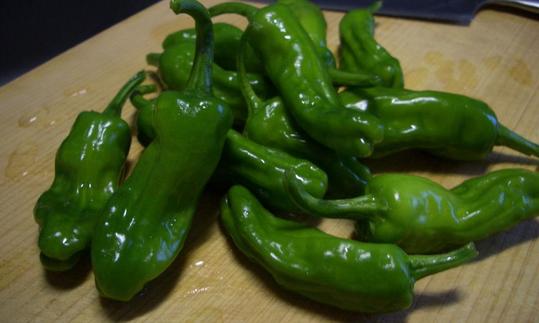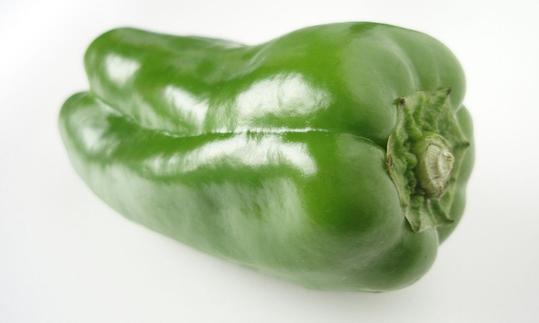Table of contents
Green bell peppers are harvested before they ripen to yellow, orange or red. This gives them a slightly bitter taste, but they are very versatile in the kitchen, both raw and processed. When buying bell peppers, make sure they are organic.
Use in the kitchen
Green bell peppers can be used raw, steamed, cooked, grilled or fried. As they contain more bitter substances, they taste more tart than yellow, orange or red peppers. Are there different types of green peppers? They are not different types; all bell peppers are green to begin with. As they ripen, they develop their color, with red peppers being fully ripe. Despite their less sweet note, there are many different recipes using green peppers. In a colorful vegetable stir-fry, they go well with tomatoes, carrots, zucchini or broccoli. It is particularly popular to stuff the peppers with wholegrain rice, couscous or quinoa together with vegetables and cook them in the oven. Or you can enjoy them Mexican-style in a vegan wrap withcorn, beans, fresh tomatoes and avocado. In its raw form, it serves as a crunchy snack between meals, e.g. with a hummus dip or as an ingredient in a raw vegetable salad.
Green sweet peppers ( Capsicum annuum) are among the milder types of peppers . The spiciness of different types of peppers within the Capsicum genus is determined by the capsaicin value, using the Scoville scale. There are roughly five levels of spiciness, with sweet peppers being classified as not spicy, with a Scoville value of 0 Scoville units. 1 Therefore, sweet peppers are mainly used in cooking and not in medicine. The spiciness is generally divided into mild (0-700 Scoville units), spicy (700-3000 Scoville units, e.g. sambal-Tabasco sauce), medium hot (3000-25,000 Scoville units, e.g. jalapeño), hot (25,000-70,000 Scoville units, e.g. serrano or cayenne pepper) and very hot (over 80,000 Scoville units, e.g. habanero). Pure capsaicin has a value of 15-16 million Scoville units. 1,2 But there are also types of pepper, such as the chili hybrid "Carolina Reaper", whose Scoville units even break the 2 million mark. 2 For more information on the Scoville scale, see hotter ingredients such as red chili peppers, green chili peppers or jalapeños.
Vegan recipe for tomato salad with green bell peppers
Ingredients (for 4 people): 3 green bell peppers (organic), 3 large tomatoes, 1 tbsp white wine vinegar, ½ tsp sugar, 1 clove of garlic, 60 ml rapeseed oil (cold pressed), ½ tsp vegetable stock,black pepper, salt.
Preparation: Halve the green bell peppers, remove the seeds and cut into 2 cm cubes. Remove the seeds from the tomatoes and cut into 2 cm pieces. Mix the tomatoes and bell peppers. For the vinaigrette, mix the vinegar, sugar, garlic, olive oil and vegetable stock. Pour the vinaigrette over the salad and season with salt and pepper. Enjoy the vegan tomato salad with green bell peppers fresh.
Vegan recipes with green bell peppers (raw) can be found under the note: " Recipes that have the most of this ingredient ".
| Not only vegans or vegetarians should read this: Vegans often eat unhealthily. Avoidable nutritional errors. |
Purchasing - Storage
The season for sweet peppers lasts from July to October. Because they are harvested earlier, green peppers are often on offer at the beginning of the season at Coop, Migros, Denner, Volg, Spar, Aldi, Lidl, Rewe, Edeka, Hofer and Billa. Organic quality is available during the season in organic supermarkets such as Denn's Biomarkt and Alnatura. When buying, make sure that the sweet peppers are brightly colored, have a firm, shiny and smooth surface and a fresh, green stem. Dull and glassy spots indicate that they are beginning to rot. Thanks to greenhouse cultivation and imports, green sweet peppers can also be bought outside of their season, primarily through online retailers.
The availability of green bell peppers varies depending on the size of the store, catchment area, etc. You can find our recorded food prices for the DA-CH countries above under the ingredient image - and by clicking you can see their development at various suppliers.
Storage tips:
Sweet peppers can be stored for the longest time in a dark and cool place, such as the cellar. In the refrigerator (vegetable compartment) they will last for about a week.
Ingredients - Nutritional values - Calories
How many calories do green peppers contain? Green bell peppers are extremely low in calories and have only 20 kcal per 100 g. They contain little fat (0.17 g/100g), little protein (0.86 g/100g) and few carbohydrates (4.6 g/100g). 3 Nevertheless, they are rich in valuable vitamins and secondary plant substances.
If you consume 100 g of green bell peppers, the amount of vitamin C covers 101% of your daily requirement. This content of 80 mg/100g can be compared to broccoli (89 mg/100g). Vitamin C is an important antioxidant that performs a variety of tasks in the immune system and is found primarily in fruits and vegetables. Yellow (184 mg/100g) and red bell peppers (128 mg/100g) contain significantly more of the vitamin. 3
The vitamin B6 content (0.22 mg/100g; 16% of the daily requirement) corresponds to that in Brussels sprouts or summer squash. The yellow bell pepper has a slightly lower content of 0.17 mg/100g, whereas the red bell pepper contains slightly more (0.29 mg/100g). The Hungarian pointed pepper contains more than twice as much of the water-soluble vitamin (0.52 mg/100g). 3
Vitamin K is present at 7.4 µg/100g, which covers 10% of the daily requirement. This amount is comparable to cherry tomatoes (7.9 µg/100g) or peeled cucumber (7.2 µg/100g). Vitamin K plays an important role in blood clotting and bone metabolism. Higher amounts are found in kale (705 µg/100g) and spinach (483 µg/100g). 3
The complete ingredients of green bell peppers, the coverage of the daily requirement and comparison values with other ingredients can be found in our nutrient tables. In the article Nutrients explained you will get a detailed insight into the topic.
Health effects
Sweet peppers are rich in secondary plant substances and contain considerable amounts of vitamins, phenolic compounds and carotenoids. The extent of these depends on the degree of ripeness and the variety. 1
Are green bell peppers healthy? Since green bell peppers are harvested before they are fully ripe, they contain fewer secondary plant substances and vitamin C than yellow, orange or red bell peppers. 4,5 Nevertheless, they can undoubtedly be described as a healthy food. Due to their low energy density, they are ideal for diabetes or for combating obesity. They stimulate gastric juices and have an anti-inflammatory effect. Their content of antioxidant vitamins A and C protects cells from carcinogens and, in particular, the digestive organs from cancer. 6
The varieties within the genus Capricum annuum are rich in capsaicin. This alkaloid, found in sweet peppers and chili peppers, is responsible for the perceived spiciness when eating a food. 7 Capsaicin has anti-cancer, antimicrobial, antioxidant, diuretic, analgesic and anti-obesity effects. 1 It is found in green sweet peppers at 1 µg/1g. 8 You can find more information about the active ingredient capsaicin in the article Chili peppers, red, raw (organic?).
Dangers - Intolerances - Side effects
The fiber-rich skin of sweet peppers can cause flatulence in people with a sensitive stomach. Peeling the peppers can help in this case.
Some people react allergically or with intolerances to the consumption of nightshade plants, such as sweet peppers. The spectrum of allergies is individual and can change over time. 9 It is also possible for cross-allergies to develop, e.g. from existing allergies to birch pollen, grass pollen, cereal pollen or mugwort pollen. 9,10 A distinction is made between real allergies and intolerance reactions. With real allergies, a strong itching in the mouth or a burning sensation in the throat often occurs immediately after eating the food. On the other hand, food intolerances manifest themselves during digestion, e.g. through flatulence or cramps. 9
Ecological footprint - animal welfare
The carbon footprint of a food depends on various factors. The decisive factors are the type of agricultural production (conventional vs. organic), production location (regional vs. imported), packaging and processing (fresh produce, frozen produce, etc.). 11 For most foods - especially the largest emitters - the majority of greenhouse gas emissions are caused by land use changes and specific agricultural practices. These two factors together cause over 80% of the ecological footprint for many foods. 18
Peppers from conventional cultivation in Germany are calculated with an ecological footprint of 0.6 kg CO 2 eq/kg. This is a high value for a vegetable and is comparable to the average value for avocado. Cauliflower, for example, only causes 0.2 kg CO2eq/kg. 11
Green bell peppers have an average global water footprint of 379 l/kg. This is a relatively high water consumption for vegetables: the global average for vegetables is 322 l/kg. By comparison, conventional tomatoes have an average of 214 l/kg. 17
When considering the ecological footprint of food, it makes sense to think about the nutritional value. Let's say you eat about 200 g of peppers. This portion uses (in this example) 40.8 l of water and provides only 40 kcal, but twice the daily requirement of vitamin C. 3, 19 A vegetable that has more vitamins, more calories and is less harmful to the environment is kale. This can of course vary from region to region. Pay attention to what can be produced in your region without much input.
According to the Lower Saxony State Office for Consumer Protection and Food Safety, sweet peppers often contain pesticide residues. In 2019, up to five different pesticide residues were found in a good two-thirds of the 84 samples. The concentrations of pesticides on the peppers were below the established acute health-endangering limit (ARfD = Acute Reference Dose). 12 Products from organic farming are generally less contaminated. Therefore, look for organic seals when buying sweet peppers.
In addition to reducing diet-related greenhouse gas emissions, reducing the ecological footprint and supporting the containment of climate change, switching to a generally sustainable diet also has an improving effect on health. 20
For detailed explanations of various sustainability indicators (such as ecological footprint, CO2 footprint, water footprint), see our article: What does the ecological footprint mean?
Worldwide distribution - cultivation
Capsicum annuum is native to Central America and northern South America. Domestication probably occurred in Mesoamerica and spread to North America and Europe. 13 In the late 15th century, peppers were introduced to Europe after they arrived on the Iberian Peninsula. Trade routes promoted their geographical spread towards the Mediterranean and from there to Africa, India and China. 14 Subtropical and temperate zones around the world offer good conditions for growing sweet peppers. In 2021, the most important producing countries included China, Mexico, Indonesia, the USA, Spain, Turkey and the Netherlands. 15 In cooler, central European countries, greenhouses are used.
Growing your own
Sweet peppers are among the vegetables that need the most warmth, which is why outdoor cultivation is only worthwhile in warm regions. If you are growing them in your own garden or on the balcony, it is best to choose a sunny location, preferably in front of a south-facing wall. To ensure success, the young plants should be grown in nutrient-poor soil so that they develop strong root growth. After that, potting soil is perfectly adequate. Direct sowing should take place in March. The peppers need a relatively large amount of water, which is why daily watering is essential in summer. Green peppers can be harvested from mid-July under good conditions. Although sweet peppers are perennial plants, overwintering them without a greenhouse or winter garden is difficult, but is only recommended for slow-growing ornamental peppers anyway. 16
Further information
Sweet peppers belong to the genus Capsicum, the nightshade family (Solanaceae). Green sweet peppers belong to the species of Spanish pepper ( Capsicum annuum). 16 In addition to sweet peppers, the Capsicum annuum includes various varieties that differ in shape, size and color. 1 Sweet peppers do not ripen after they are harvested, which is why green - actually still unripe - peppers keep their color. In addition to the commercially available yellow, orange and red colors, there are also dark purple and black varieties.
What do you call the light green pepper? The light green pepper "Citrina" is a special cultivated form of Capsicum annuum. It is not usually available in regular supermarkets, but can be purchased online or sometimes at vegetable markets.
Alternative names
Alternative names are Spanish pepper, block pepper, biting pepper, pod pepper, sweet pepper and bell pepper. In Switzerland, pepper is called "pepperoni" and paprika refers to the red spice powder.
In English, green bell peppers are called "green pepper", "green paprika" or "green capsicum".
Bibliography - 20 Sources (Link to the evidence)
| 1. | Hernández‐Pérez T, Gómez‐García M del R et al. Capsicum annuum (hot pepper): An ancient Latin‐American crop with outstanding bioactive compounds and nutraceutical potential. A review. Comp Rev Food Sci Food Safe. 2020;19(6):2972–2993. |
| 2. | Focus de: Scoville-Skala - So ist die Schärfe-Tabelle aufgebaut. 2017. |
| 3. | USDA United States Department of Agriculture. |
| 4. | Kumar O, Tata S. Ascorbic Acid Contents in Chili Peppers (Capsicum L.). Not Sci Biol. 2009;1(1):50–52. |
| 5. | Sun T, Xu Z et al. Antioxidant activities of different colored sweet bell peppers (Capsicum annuum L.). J Food Science. 2007;72(2):98–102. |
| 6. | Roger J.D.P. Heilkräfte der Nahrung, Praxishandbuch. Advent-Verlag Zürich. 3. Auflage 2008. |
| 7. | Chemie de: Capsaicin. |
| 8. | Othman ZAA, Ahmed YBH et al. Determination of capsaicin and dihydrocapsaicin in Capsicum fruit samples using high performance liquid chromatography. Molecules. 2011;16(10):8919–29. |
| 9. | Gesundu de: Nahrungsmittelallergie auf Nachtschattengewächse. 2019. |
| 10. | Ernaehrung de: Nahrungsmittelallergien-Pollen. |
| 11. | Reinhardt G, Gärtner S, Wagner T. Ökologische Fussabdrücke von Lebensmitteln und Gerichten in Deutschland. Institut für Energie- und Umweltforschung Heidelberg ifeu. 2020:1-22. |
| 12. | Niedersächsisches Landesamt für Verbraucherschutz und Lebensmittelsicherheit. Pflanzenschutzmittelrückstände in Gemüsepaprika? |
| 13. | Brücher H. Tropische Nutzpflanzen. Ursprung, Evolution und Domestikation. Springer Verlag. Berlin. 1976. |
| 14. | Silvar C, Rocha F, Barata AM. Tracing back the history of pepper (Capsicum annuum) in the iberian peninsula from a phenomics point of view. Plants. 2022;11(22):3075. |
| 15. | FAO org: Crops and livestock products. Chillies and peppers, green. 2021. |
| 16. | Mein schöner Garten de: Paprika (Capsicum). 2023. |
| 17. | Mekonnen MM, Hoekstra AY. The green, blue and grey water footprint of crops and derived crop products. Hydrol. Earth Syst. Sci. 2011;15:1577-1600. |
| 18. | Ritchie H, Roser M. You want to reduce the carbon footprint of your food? Focus on what you eat, not whether your food is local. Our World in Data [Internet]. 2020. |
| 19. | Foodfootprint nl: Climate impact Bell pepper. |
| 20. | Laine JE, Huybrechts I et al. Co-benefits from sustainable dietary shifts for population and environmental health: an assessment from a large European cohort study. Lancet Planet Health. 22. October 2021;5(11):e786–796. |













Comments